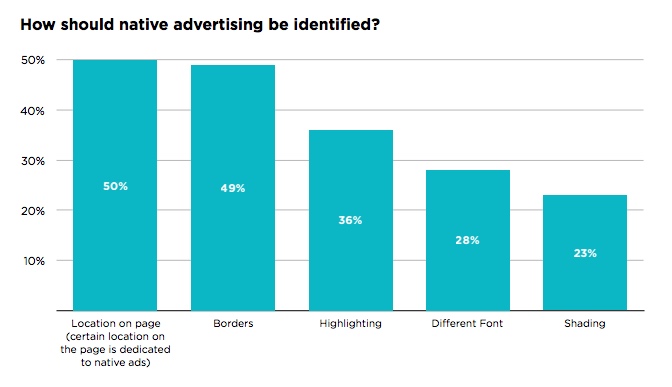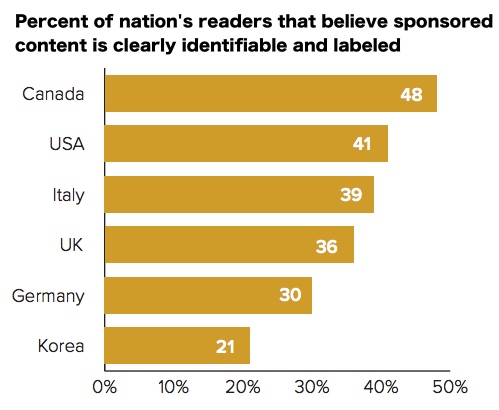Save 50% on a 3-month Digiday+ membership. Ends Dec 5.

One of the true bright spots for publishers could wind up further eroding the value of their most precious asset.
With display advertising in a free fall — and what little of value there is being sucked up by Google and Facebook –publishers are increasingly turning to native advertising and sponsored content to earn meaningful revenue. The New York Times, for example, now earns nearly 20 percent of its digital revenue from its T Brand Studios.
The only problem is that sponsored content, despite being decades old as an concept, remains confusing to readers. They sometimes struggle to identify it, have mixed emotions about its being in the same place as regular editorial content, and often feel like publishers must be held to higher standards.
Here are five charts that illustrate the increased risks sponsored content poses to publishers, and what they’re doing about it.
Trust issues
While the wrong kinds of ads can diminish readers’ opinion of a publisher, this dynamic is especially pronounced when it comes to native ads and sponsored content. Nearly half of the respondents to a survey conducted by Contently, in partnership with the Tow-Knight Center for Entrepreneurial Journalism at CUNY and Radius Global Market Research, said a publisher that runs sponsored content produced for a brand readers distrust can wind up diminishing readers’ opinions of the publisher. The Atlantic took a nasty beating for running content sponsored by the Church of Scientology a few years ago, but that’s by no means the only example.

Keep it separate?
One of the biggest draws of native advertising is the real estate it occupies. As more and more content consumption happens inside feeds, either on publishers’ websites or on third-party platforms, advertisers are relishing the opportunity to integrate their messages into that flow.
Ad position: web_incontent_pos1
Unfortunately for publishers, the public is divided on whether or not that’s a good thing, according to the study conducted by Contently, CUNY and Radius.

Label warning
That anxiety stems from a lot of readers feeling confused by what, exactly, sponsored content is. A majority of people surveyed do not believe that sponsored content is labeled clearly, according to research conducted by Reuters. This problem is even more acute in foreign countries.

Confusion breeds anger
That confusion, along with the other issues outlined above, has led a substantial percentage of readers to complain about the native ads publishers run. Research published in late October by the International News Media Association and the Native Advertising Institute found that a full fifth of news media publishers surveyed reported that they’d received complaints from their readers about native advertising.
Ad position: web_incontent_pos2

Scrambling
Perhaps because of how sensitive readers can be, publishers have been scrambling to improve the transparency around what is sponsored and what is not on their sites. Many of them had a lot of ground to cover: A Mediaradar analysis published this spring indicated nearly three quarters of all publishers running sponsored content were doing so in a way that was not compliant with FTC regulations.
Barely six months later, that number has changed dramatically, according to a Mediaradar follow-up: A majority, or 61 percent, of publishers that run sponsored content now do it in a way that’s FTC-compliant.
More in Media

What publishers are wishing for this holiday season: End AI scraping and determine AI-powered audience value
Publishers want a fair, structured, regulated AI environment and they also want to define what the next decade of audience metrics looks like.

Digiday+ Research Subscription Index 2025: Subscription strategies from Bloomberg, The New York Times, Vox and others
Digiday’s third annual Subscription Index examines and measures publishers’ subscription strategies to identify common approaches and key tactics among Bloomberg, The New York Times, Vox and others.

From lawsuits to lobbying: How publishers are fighting AI
We may be closing out 2025, but publishers aren’t retreating from the battle of AI search — some are escalating it, and they expect the fight to stretch deep into 2026.
Ad position: web_bfu



